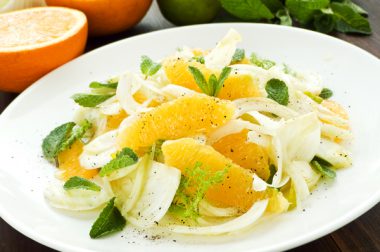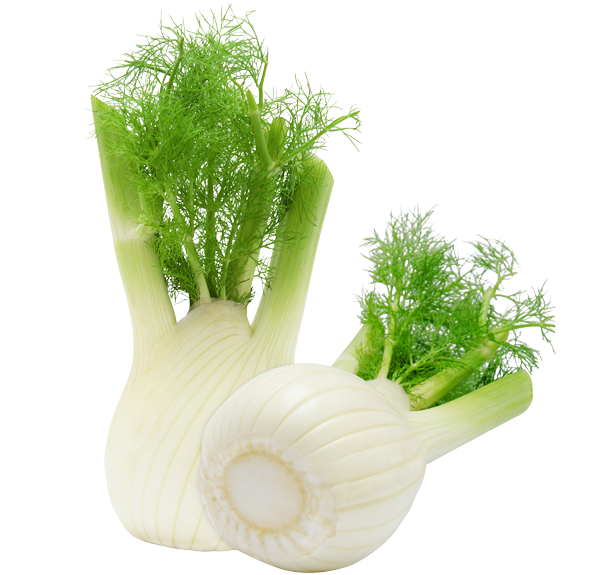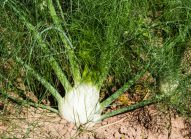Recipes we love
See all recipesFennel cream
These sauces will be perfect with white meat, fish, cold meat… They are very quick and easy to prepa...
Fennel with white wine and shallots
An ultra-light, ultra-quick recipe with plenty of flavour, perfect for serving with a whole or fille...
Fennel with cream
A quick and delicious way of enjoying this unique, tasty vegetable. Vitamin C is sensitive to oxygen...
Health
benefits
A natural diuretic
Because of its high potassium content and low sodium content, fennel has natural diuretic properties.
Fennel leaves full of antioxidants
Fennel leaves are rich in polyphenols—powerful antioxidants, comparable to those found in aromatic herbs. How about using them to flavor your salads or poaching liquid?
Fennel is also:
- a source of vitamin B9 (for cellular renewal, particularly important for pregnant women for fetal development, for growing children, and for convalescents).
- a source of potassium (for the nervous system, muscular function, and blood pressure
It also contains vitamin C.
Nutritional
composition
When is the right time to eat it?
From May to December
Fennel is available year-round, but its high season lasts from May to December.
Vegetable patch
or urban balcony?
Fennel grows well in rich, cool, and fairly light soil rich in humus, in a sunny spot. Fennel also prefers mild and temperate regions.
To learn everything you need to know about growing fennel, read the page on growing advice.
Choosing
and storing fennel
Choose the right fennel:
- The bulb should be white and firm, without spots, and should give off a light anise scent.
- Small bulbs are the most flavorful.
- The leaves should be green and fragrant and should not be wilted.
Properly store your fennel:
- In the refrigerator: Four to five days in the vegetable drawer in a sealed container.
Tips
and tricks
How to prepare fennel
Put the stems and leaves aside (to be used later). Remove any damaged parts from the bulb and cut it as you like.
Cooking times:
- 10 mins: in a pan or wok
- 15 mins: steamed, in the pressure cooker
- 20 mins: in boiling water
Fennel goes well with…
Raw or cooked, fennel does not need much salt. Its anise-like flavor makes it stand out all by itself!
Raw: Prepare with bell peppers, tomatoes, beans, lemon, cold potatoes, avocado, citrus fruits, ham, feta, etc.
Cooked: The anise-like flavor of fennel that it shares with dill and celery enhances the salty flavors of seafood. It also goes very well with white meat and can be added to risotto, pasta, and couscous. Combined with potatoes, it makes for a delicious Belgian stoemp and for savory purées with a note of anise.
Fennel can also be used in sweet recipes! It can be mixed with apples, pears, and a bit of spice (curry and ginger) for a succulent dessert.
Can everyone eat them?

Young children
Fennel in purée form can be fed to children starting at 12 months, an age when they will more easily accept the strong flavor of anise.
Did you know? Essential fennel oil has numerous compounds that have a gentle, soothing effect on infants’ digestion. It can be used in situations that include colic, constipation, flatulence, or slow digestion.
And everyone else
Some people who are allergic to pollen may experience an oral allergic reaction when eating fennel. Ask a health professional for advice.
See plenty of other tips for encouraging children to eat vegetables
Where does it come from?
Origins and varieties
Origins
Most fennel production in the world takes place in Italy, which is also the number one consumer. However, Spain, the Netherlands, Israel, Turkey, Egypt, and the United States are also producers. It is not cultivated on a large scale in Canada, but it is still possible to find fennel produced in Quebec at markets from June to September.
Varieties
There are different varieties of fennel, including three main varieties:
- Bitter fennel (wild fennel) has green stalks that grow from the base of the bulb. The ends of the leaves are quite jagged.
- Sweet fennel has a larger bulb than bitter fennel, with thicker, white stems, and very green leaves. This variety has an anise taste that is less bitter than that of bitter fennel.
- Today, the most common variety is Florence fennel, or finocchio.



 Jerusalem artichoke
Jerusalem artichoke  Onions
Onions  Vegetable garden: growing turnip
Vegetable garden: growing turnip 










